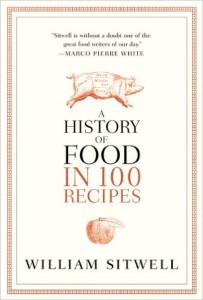 Some books are so obvious that I wonder why it hasn’t been done before. Indeed I suspect it is, but this take on it is certainly a very good one. Iain ordered it for the Estate Library and passed it along to me knowing my great love of culinary books, particularly the ones with a historical perspective. It’s a simple concept stated clearly in the title: tell the history of food through the recipes that reflect that history. Ok, I just restated the titles in different words.
Some books are so obvious that I wonder why it hasn’t been done before. Indeed I suspect it is, but this take on it is certainly a very good one. Iain ordered it for the Estate Library and passed it along to me knowing my great love of culinary books, particularly the ones with a historical perspective. It’s a simple concept stated clearly in the title: tell the history of food through the recipes that reflect that history. Ok, I just restated the titles in different words.
The book itself is one of the many new ones that comes sans dust jacket with the cover art you see to left printed directly on the book itself along with the spine and back cover material. I’m not fond of putting a pull quote on the cover as its a bit unnecessary as anyone buying this book is likely only attracted to the title and the tasteful artwork.
It starts off with an intro by the author explains how it came to be and his background as collector of cookbooks, lots of cookbooks and related ephemera. From there he explains which texts were crucial to his writing of A History of Food in 100 Recipes. Then follows a note on the recipes in that he tried not to change the recipes unless absolutely needed. That doing so results more in a delicious read more than a practical cookbook. Having read medieval Swedish recipes from sources from that period, it’s safe to say that duplicating them in the modern kitchen would be difficult given the ingredients, the preparation methods, and even the cooking methods would be extremely challenging.
The first recipe is for ancient Egyptian bread with the recipe given (English translation of course) followed by an I depth look at the recipe, the author, and the context of Egyptian society at that time, circa 1958 – 1913 BC given the centrality of bread in that culture.
The last recipe is for Meat Fruit (foie gras and chicken liver parfait). Trust me: this is not a dish you’ll find Mrs. Ware and her staff here serving here ever. Nor do I have the slightest desire to even sample it as it sounds like something that the Royals ate in pre-Revolutionary France while peasants starved! Speaking of from that period, there’s Capon de galera, a chicken soup that sounds wonderful!
Now I shouldn’t focus on the tasty recipes as its a fascinating read from end to end, but I will. My review, my choices. So we have cheese tart (1450), hot chocolate (1566), ice cream (1718), cupcakes (1828), kedgeree (1845), strawberry shortcake (1896), toad in the hole (1927), and, surprisingly recent in my mind, beef stew in red wine with bacon, mushrooms, onions from 1961.
Now keep in mind that many of these recipes predate the first time that they enter the historic records by years, if not a lot longer. As with history until the written record reached down from the gentry down to the common folk, what happened in their society was largely unknown. So a stew made like the beef stew which dates from allegedly dates from 1961 is likely something cooked up for centuries before that given how common the ingredients are.
All in all, A History of Food in 100 Recipes is a book I’ll wholeheartedly recommend to anyone interested in culinary history. And you knows, you might find something worth cooking up here. If you haven’t tried a favourite dish of mine, kedgeree, a dish from the years of British rule in India, it’s worth a try.
(Little, Brown UK, 2013)
